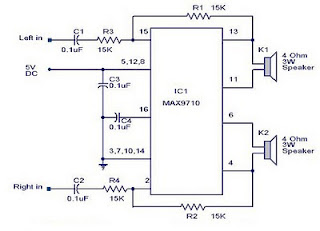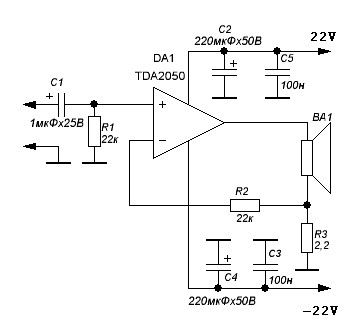
3W Stereo Amplifier schematic

A 3-watt stereo amplifier circuit utilizing the MAX9710 integrated circuit (IC). The MAX9710 is a stereo audio power amplifier IC capable of delivering 3 watts of output to 4-ohm loads. It can operate from a single power supply ranging from 4.5V to 5.5V, making it ideal for handheld applications. This IC also includes thermal overload protection. The 3-watt stereo amplifier circuit is suitable for small power audio devices such as radio sets and portable CD players. A 5V DC power supply is used to power the 3-watt stereo amplifier circuit. Alternatively, a 6V battery can be employed with an IN4007 diode connected in series to the positive terminal, which results in an approximate supply voltage of 5V after a 0.7V drop across the diode.
The 3-watt stereo amplifier circuit based on the MAX9710 IC is designed for applications requiring compact audio amplification. The MAX9710 is particularly advantageous due to its ability to deliver adequate power to 4-ohm speakers, ensuring clear audio playback without distortion at moderate volume levels. The operational voltage range of 4.5V to 5.5V allows for flexibility in power supply selection, making it suitable for battery-operated devices.
In this circuit, the MAX9710's thermal overload protection feature safeguards the amplifier from damage due to excessive heat, enhancing its reliability in various operating conditions. The circuit can be powered by a regulated 5V DC source, which is commonly available in many electronic devices. Alternatively, using a 6V battery with an IN4007 diode ensures that the voltage supplied to the amplifier remains within the acceptable range, despite the inherent voltage drop across the diode.
The overall design of the 3-watt stereo amplifier circuit prioritizes efficiency and performance, making it an excellent choice for integration into portable audio devices. Its compact size and low power requirements make it suitable for use in applications such as portable music players, handheld radios, and other small electronic audio devices. Proper layout considerations, including minimizing trace lengths and ensuring adequate decoupling, are essential for optimal performance and audio fidelity.3 Watt stereo amplifier circuit using MAX 7910 IC. The MAX9710 a stereo audio power amplifier IC capable of delivering 3Watts of out put to 4 Ohm loads. MAX9710 can be operated from a single 4. 5V to 5. 5V power supply, makes it ideal for hand held applications. The IC for3 Watt stereo amplifier circuitalso features thermal overload protection. This3 Watt stereo amplifier circuitis suitable for small power audio devices such as radio sets and portable CD players. 5 V DC power supply is used for powering the3 Watt stereo amplifier circuit. 6V battery with an IN 4007 diode series to the positive terminal of it can also be used instead of 5 V DC supply.
The3 Watt stereo amplifier circuitwill get a supply voltage approximately 5 V after 0. 7 V voltage drop across diode. 🔗 External reference
The 3-watt stereo amplifier circuit based on the MAX9710 IC is designed for applications requiring compact audio amplification. The MAX9710 is particularly advantageous due to its ability to deliver adequate power to 4-ohm speakers, ensuring clear audio playback without distortion at moderate volume levels. The operational voltage range of 4.5V to 5.5V allows for flexibility in power supply selection, making it suitable for battery-operated devices.
In this circuit, the MAX9710's thermal overload protection feature safeguards the amplifier from damage due to excessive heat, enhancing its reliability in various operating conditions. The circuit can be powered by a regulated 5V DC source, which is commonly available in many electronic devices. Alternatively, using a 6V battery with an IN4007 diode ensures that the voltage supplied to the amplifier remains within the acceptable range, despite the inherent voltage drop across the diode.
The overall design of the 3-watt stereo amplifier circuit prioritizes efficiency and performance, making it an excellent choice for integration into portable audio devices. Its compact size and low power requirements make it suitable for use in applications such as portable music players, handheld radios, and other small electronic audio devices. Proper layout considerations, including minimizing trace lengths and ensuring adequate decoupling, are essential for optimal performance and audio fidelity.3 Watt stereo amplifier circuit using MAX 7910 IC. The MAX9710 a stereo audio power amplifier IC capable of delivering 3Watts of out put to 4 Ohm loads. MAX9710 can be operated from a single 4. 5V to 5. 5V power supply, makes it ideal for hand held applications. The IC for3 Watt stereo amplifier circuitalso features thermal overload protection. This3 Watt stereo amplifier circuitis suitable for small power audio devices such as radio sets and portable CD players. 5 V DC power supply is used for powering the3 Watt stereo amplifier circuit. 6V battery with an IN 4007 diode series to the positive terminal of it can also be used instead of 5 V DC supply.
The3 Watt stereo amplifier circuitwill get a supply voltage approximately 5 V after 0. 7 V voltage drop across diode. 🔗 External reference





